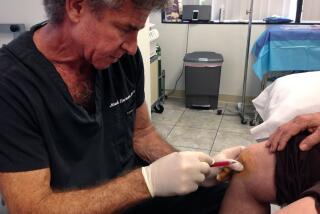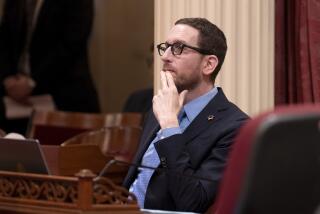Stem cell program needs therapy
In the annals of wrongheaded things done with the best intentions, the California stem cell program has always been in a category of its own.
The $6-billion program was enacted by voters in 2004 as Proposition 71 after a campaign of exceptional intellectual dishonesty, featuring vignettes of sufferers from diabetes, Alzheimerās, Parkinsonās and other heartbreaking diseases for which it seemed to promise imminent cures through research into embryonic stem cells.
As conceived by a Northern California real estate man named Robert Klein, who remains the programās chairman and guiding spirit, the idea was that California would fill the vacuum created by the Bush administrationās ideology-inspired ban on federal funding for much of this research. (President Obama rescinded the ban this month.) The state, according to the hype, would reap billions in profits from the therapies it funded.
No one would dispute that finding cures for Alzheimerās, cancer or diabetes is a worthy, even urgent, goal. To its credit, the California Institute for Regenerative Medicine has placed the state at the center of the world of embryonic stem cell research by committing hundreds of millions of dollars in grants for the construction of state-of-the-art labs and the training of a new generation of scientists.
But the program threatens to suck up precious fiscal resources of a state with none to spare and is rife with conflicts of interest. Its commitment to public disclosure is spotty. Now itās planning to hand over up to $400 million in taxpayer funds to the biotech industry on terms that may multiply the potential for conflicts and waste.
The institute is tangled in a persistent ethical morass. From the start, its safeguards against conflicts of interest by members of its 29-person governing board were sketchy, and provisions for vigorous debate over its goals and methods were nil.
Despite a provision in Proposition 71 forbidding a board member to attempt to influence āin any wayā a decision involving his or her employer, in 2007 board member John C. Reed tried to get the instituteās staff to reverse the rejection of a grant for the La Jolla-based Burnham Institute for Medical Research, of which he is chief executive. The staff refused. Reed, who should have been bounced from the board, got his wrist slapped by state ethics officials instead.
Meanwhile, 18 institutions with representatives on the board have received portions of $552 million in grants from the institute. (I am indebted to David Jensen of the California Stem Cell Report, one of the programās outstanding bird dogs, for this math.)
Such logrolling is perhaps inevitable, given that Proposition 71 restricted the boardās membership to officers of California research institutions and biotech companies, along with advocates for research in 11 diseases supposedly subject to stem cell-driven cures.
Lacking any truly independent members, the board is dominated by Klein and devoid of āgenuine debate,ā observes UC Berkeley Law professor Kenneth Taymor, who spent months studying the body. Indeed, reading transcripts of the boardās sessions, one sometimes gets the impression that the only vigorous debate among the members involves which historical figure Klein more resembles, Albert Schweitzer or Mahatma Gandhi.
That brings us to the instituteās 2009 strategic plan, which calls for floating $400 million in taxable state bonds, much of it earmarked for loans to the biotech industry to finance the development of specific therapies.
Is this the best way to spend the stateās money? Klein says the great virtue of making loans is that, because the money gets repaid, it can be used over and over again. Thatās assuming that it does get repaid. Some of the loans, furthermore, will be non-recourse, meaning that if the product fails or canāt get further funding before the loan is repaid, the debt will be written off.
The loansā target is the āvalley of death,ā the phase of product development that follows publicly funded basic research and precedes clinical trials. Biotech firms traditionally have a hard time raising capital for this phase, because itās very costly and speculative, suggesting that Klein is counting unhatched chickens.
But he is ever optimistic: āThe first major breakthrough will change the world,ā he told me.
Part of the reason for the move into product development is that the instituteās chronic cash crunch -- an outgrowth of the stateās financial crisis -- has forced it to scale back or delay some basic research grants. Without a new financial infusion, the institute says, it may run out of money in September.
But the shift away from basic research isnāt universally welcomed in Californiaās scientific community.
āThe foundations for stem cell biology are still being constructed, and that takes basic science,ā says Arnold Kriegstein, a neurologist at UC San Francisco who raised the issue at a recent meeting of the instituteās board.
Kriegstein contends that in much of stem cell research, product development is premature. He fears that the move in that direction is motivated by a ādesire to come up with a real clinical triumph they could claim credit for. Iām concerned that in the rush to get there they may be spending a fair amount of funds on projects that are just not ready yet.ā
Marie Csete, the instituteās chief scientific officer, says Kriegsteinās concerns are overwrought. āWe have no intention of abandoning basic science,ā she told me, observing that the institute has helped fund more than $600 million in training, research and infrastructure over the last four years. āWeāve supported basic research in a huge way.ā
She also strongly disagreed that the time is not ripe for product development. āThereās very mature work that is quite close to clinical applications,ā she said, adding that just because there are gaps in our knowledge of stem cell biology doesnāt mean all development efforts need to be put on hold.
With the change of administrations in Washington and the deterioration in the stateās fiscal health, the time has come for a fundamental rethinking of the stem cell program. The debate over its future has to take place in the context of the stateās overall needs, not merely among a small group of self-interested board members.
Proposition 71 endowed the program with what looked like an embarrassment of riches. The danger is that, without better oversight and broader debate about its policies and goals, it will become simply an embarrassment.
--
Michael Hiltzikās column appears Mondays and Thursdays. Reach him at [email protected] and read his previous columns at www.latimes.com/hiltzik.







